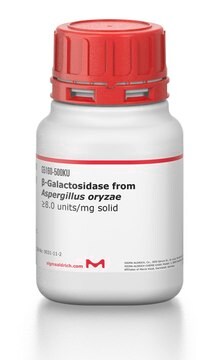SCP0116
Chromogranin A (324-337) WE 14 human
Iniciar sesiónpara Ver la Fijación de precios por contrato y de la organización
About This Item
Fórmula empírica (notación de Hill):
C72H116N18O24S1
Peso molecular:
1649.86
Código UNSPSC:
12352200
NACRES:
NA.32
Productos recomendados
Ensayo
≥95% (HPLC)
Formulario
lyophilized
composición
Peptide Content, ≥68%
condiciones de almacenamiento
protect from light
temp. de almacenamiento
−20°C
Amino Acid Sequence
Trp-Ser-Lys-Met-Asp-Gln-Leu-Ala-Lys-Glu-Leu-Thr-Ala-Glu
Aplicación
Chromogranin A (parathyroid secretory protein 1) is a precursor of the vasostatin, pancreastatin, catestatin, parastatin, chromostatin, GE-25 and WE-14. WE 14 is used to search for its as yet undefined physiological roles.
Código de clase de almacenamiento
11 - Combustible Solids
Clase de riesgo para el agua (WGK)
WGK 3
Punto de inflamabilidad (°F)
Not applicable
Punto de inflamabilidad (°C)
Not applicable
Elija entre una de las versiones más recientes:
Certificados de análisis (COA)
Lot/Batch Number
¿No ve la versión correcta?
Si necesita una versión concreta, puede buscar un certificado específico por el número de lote.
¿Ya tiene este producto?
Encuentre la documentación para los productos que ha comprado recientemente en la Biblioteca de documentos.
Per-Gøran Krüger et al.
Regulatory peptides, 114(1), 29-35 (2003-05-24)
Catestatin (bovine CgA(344-364)) is a cationic peptide, which besides reducing catecholamine secretion from chromaffin cells in vitro also acts a potent vasodilator in the rat in vivo. The alleged histamine releasing effect of catestatin was tested in vitro in rat
The modulatory effects of WE-14 on histamine release from rat peritoneal mast cells.
P Forsythe et al.
Inflammation research : official journal of the European Histamine Research Society ... [et al.], 46 Suppl 1, S13-S14 (1997-03-01)
William James Curry et al.
Microscopy research and technique, 62(5), 408-414 (2003-11-06)
WE-14 is generated in subpopulations of chromogranin A immunopositive endocrine cells and neurons including those innervating the anterior uvea. This study investigated WE-14 in intact sclero-limbo-corneal tissue from embryonic (E17), neonatal (N0-N16), and adult mice using immunocytochemistry and confocal scanning
W J Curry et al.
Annals of the New York Academy of Sciences, 971, 311-316 (2002-11-20)
The neuropeptide WE-14 is derived from the posttranslational processing of chromogranin A (CgA). While CgA is expressed in a preponderance of neuroendocrine cells, WE-14 is generated in a distinct subpopulation of CgA-immunopositive cells, most notably in the adrenal, pituitary, and
Carmel Mary McVicar et al.
Regulatory peptides, 115(1), 1-10 (2003-07-23)
Immunohistochemical analysis of the male and female rat adenohypophysis revealed that chromogranin A (CgA), beta-granin and WE-14 immunostaining was localised to follicle stimulating hormone (FSH) producing cells, while luteinizing hormone (LH) producing cells exhibited chromogranin A and beta-granin immunostaining. The
Nuestro equipo de científicos tiene experiencia en todas las áreas de investigación: Ciencias de la vida, Ciencia de los materiales, Síntesis química, Cromatografía, Analítica y muchas otras.
Póngase en contacto con el Servicio técnico




